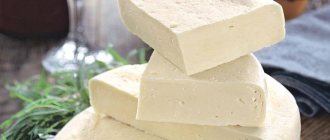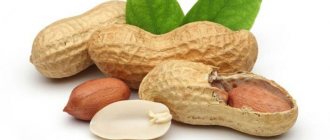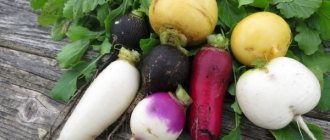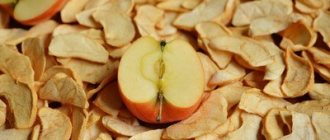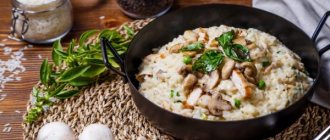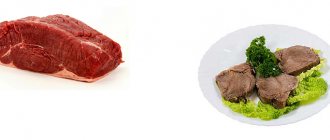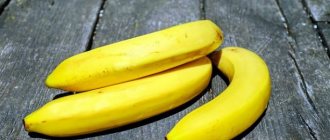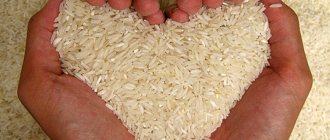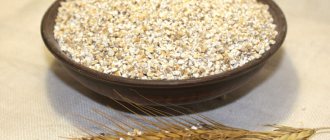Adyghe cheese is one of the varieties of pickled cheeses that belong to the national dishes of Circassian cuisine. It belongs to the group of soft cheeses, such as feta or feta cheese, produced in Adygea. This product is a low-calorie fermented milk product, the regular consumption of which helps strengthen bones. Due to the content of useful substances in it, eating Adyghe cheese also has a beneficial effect on the condition of the stomach, intestines and nervous system of a person.
General characteristics of the product
Content:
- General characteristics of the product
- Varieties of dairy product
- Chemical composition
- Use in cooking
- Features of industrial production
- How to make Adyghe cheese at home
- How to choose and store the product correctly
Adyghe or Circassian cheese is a national dish of the Circassian culinary tradition [1]. Its name was formed due to its territorial affiliation. The first industrial batches of cheese were produced in the Republic of Adygea by the Circassian population [2]. Cheese bars were made from whole goat or cow's milk. Later, as the industry became larger and more influential, producers switched to cow's milk to reduce the cost of production [3].
The product belongs to the category of soft cheeses without ripening. It has a muted sour milk taste, delicate texture and neutral aroma. There are only 2 variations of industrial dairy products: smoked and fresh. In the photo and even on store shelves, Adyghe cheese can easily be confused with mozzarella, feta cheese, ricotta, mascarpone or feta. But the main difference between the product produced by the Circassian people is pasteurization. The milk mixture is subjected to heat treatment, then fermented milk whey is introduced and the milk protein is allowed to precipitate. The external shape of the cheese is made primarily in the shape of a cylinder with convex side surfaces and rounded edges.
The taste of the product is clean, spicy, fermented milk. A sophisticated consumer will notice the specific taste of pasteurization and the subtle salty taste of whey protein. Its structure is moderately delicate, but not loose. The shade can vary from snow-white to light yellow. GOST allows individual cream spots on the surface of the bar and sections [4]. Adyghe cheese does not have a crust. Small slot-like voids and slight layering are allowed on the surface.
Beneficial features
The benefits of the Adyghe fermented milk product are beyond doubt, because it:
- restores the functioning of the gastrointestinal tract and normalizes intestinal microflora;
- low calorie content allows you to reduce excess weight;
- useful for people with hypertension;
- improves sleep and reduces stress;
- preserves bone tissue, tooth enamel and healthy nails and hair;
- accelerates the decomposition of fats due to phosphorus;
- slows down cell aging by synthesizing collagen;
- fights viruses and removes toxins, improves immunity due to its zinc content.
We will tell you in this article what types of low-fat cheese there are.
You can read about the benefits and harms, calorie content and recipes of sausage cheese here
How to make cheese at home from cow's milk - read on our website
Varieties of dairy product
Important: industrial Adyghe cheese can be found throughout the post-Soviet space. Recipes may differ in each country. Moreover, a similar product can be sold under different trade names [5]. Be careful before purchasing.
Homemade Adyghe cheese, unlike industrial cheese, can be found in 3 different variations: fresh, dried and smoked. Fresh is practically no different from what is sold on supermarket shelves. However, a homemade product may contain rennet. If its presence/absence plays an important role for you, then be sure to check the information with the seller.
Smoked Circassian cheese has several names: red, Armavir or Kabardian. The product has gained particular popularity in the western part of the North Caucasus. It is smoked for several days until the crust becomes dense and impenetrable to bacteria or air. The shelf life of smoked dairy products is 6 months.
Dried Adyghe cheese is very similar to local kurt (fermented milk cheese balls). Since ancient times, this product served as food for shepherds, warriors and hunters. Dried cheese is very salty and hard. It retains only 20% moisture and 2% salt. Locals dry the bars in the shade, after which they are poured into huge boxes, covered with a layer of grain and sent to a barn with a stable temperature and stable humidity. Its shelf life can reach several years.
Interesting: before use, the dried head is doused with boiling water or dipped in boiling water. The product instantly becomes soft and pliable, but its structure is still denser compared to classic Adyghe cheese.
Gourmet Recipes
Salad with tuna and Adyghe cheese in pesto sauce
KBJU per serving - 323 kcal/31.2 g/16.7 g/4.2 g
Ingredients:
- Adyghe cheese - 150 g;
- canned tuna without oil - 1 can;
- cherry tomatoes - 250 g;
- pesto - 1 tbsp;
- ground black pepper, garlic - to taste.
Place tuna without liquid in a salad bowl, add pesto with pepper and garlic and mix. Add finely chopped cubes of Adyghe cheese and cherry halves to the bowl, mix.
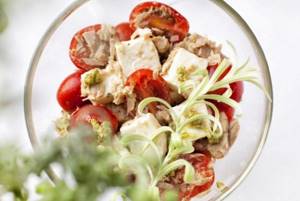
Chicken rolls with mushrooms
KBJU per serving: 156 kcal/26.7 g/3.4 g/5 g
Ingredients:
- soy sauce - 50 ml;
- chicken breast - 370 g;
- fresh champignons – 190 g:
- onions - 1 pc.;
- Adyghe cheese - to taste;
- olive oil - 1 tbsp;
- spices - to taste.
Marinate a chicken breast cut lengthwise in soy sauce and your favorite spices for half an hour or (if you have time) an hour. Fry finely chopped onion in oil. Add chopped mushrooms and spices to it and simmer for 10 minutes under the lid. Cook until the liquid evaporates. Form chicken rolls by stuffing the breast with the resulting mixture and adding a few pieces of Adyghe cheese, and secure with toothpicks. Bake without oil on foil for 25 minutes.

Brussels pie
KBJU: 398 kcal/28.8 g/16.5 g/28.2 g
Ingredients:
- Adyghe cheese - 300 g;
- crumbly cottage cheese - 200 g;
- wheat flour - ⅓ cup;
- buckwheat flour - ⅓ cup;
- oatmeal - ⅓ cup;
- baking powder - 1 tsp;
- Mexican vegetable mixture - 180 g;
- garlic - 2 cloves;
- Brussels sprouts - 6 pcs.;
- hard cheese - 100 g;
- chicken egg - 1 pc.;
- salt, pepper mixture - to taste.
In a blender, puree garlic, eggs, cottage cheese and Adyghe cheese. Mix the flour, flakes and powder and add to the liquid mixture, knead the dough. Place it in a baking dish, spread the defrosted cabbage florets, cut into 4 pieces, on top, and then the Mexican mixture. Sprinkle the vegetables with finely grated cheese and add pepper. Bake at 180°C for 35 minutes.
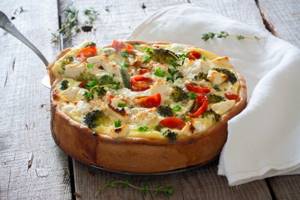
Puff pastries with pear, onion and cheese
KBJU: 428 kcal/13.3 g/25.5 g/33.6 g
Ingredients:
- puff pastry - 250 g;
- chicken egg - 1 pc.;
- greens - to taste
- pear - 1 pc.;
- Adyghe cheese - 150 g;
- olive oil - 1 tbsp;
- salad onion - 1 head.
Cut the rolled out dough into 4 squares and form sides. Brush with beaten egg. Cut the peeled pear into slices. Fry the onion rings in a frying pan until soft and leave to cool. Place equal amounts of onion, pear and diced cheese on the pieces. Bake for 15 minutes at 200°C.
Chemical composition
Important: the product is prepared on the basis of pasteurized milk, whey and table salt. It is classified as a dietary food with high nutritional value and rich nutrient composition [6]. The mass fraction of fat in dry matter is 40%.
Nutritional value per 100 grams
| Calorie content [7] | 264 kcal |
| Squirrels | 19.8 g |
| Fats | 19.8 g |
| Carbohydrates | 1.5 g |
| Alimentary fiber | 0 g |
| Water | 56 g |
| Alcohol | 0 g |
| Cholesterol | 54 mg |
| Ash | 2.8 g |
Vitamin composition (in milligrams per 100 grams)
| Retinol (A) | 0,213 |
| Beta-carotene (A) | 0,1 |
| Tocopherol (E) | 0,3 |
| Ascorbic acid (C) | 0,2 |
| Thiamine (B1) | 0,04 |
| Riboflavin (B2) | 0,3 |
| Niacin (B3) | 0,3 |
| Nicotinic acid (PP) | 5,7 |
Concentration of minerals (in milligrams per 100 grams)
| Macronutrients | |
| Potassium (K) | 70 |
| Calcium (Ca) | 520 |
| Magnesium (Mg) | 25 |
| Sodium (Na) | 470 |
| Phosphorus (P) | 360 |
| Microelements | |
| Iron (Fe) | 0,6 |
Calorie content
100 g of Adyghe cheese contains about 230-265 kcal (approximately 12.8% of the daily value). Its fat content, depending on the milk used, can be 15–50%.
When preparing dishes using Adyghe cheese, it is convenient to use the following data:
| Amount of grated cheese | Weight | Calorie content |
| 1 tsp | 5 g | 13.2 kcal |
| 1 tbsp. | 15 g | 39.6 kcal |
| 1 cup (200 ml) | 96 g | 253.4 kcal |
| 1 glass faceted (250 ml) | 120 g | 316.8 kcal |
Those who are on a diet should make their own cheese. In this case, you can significantly reduce the amount of fat and total calories.
You can make slices of cheese tastier by frying them in butter. To reduce calorie content, cheese can be fried without oil. Unlike other cheeses, Adygei cheese does not melt and releases its own fat, which prevents it from burning. The resulting product will have a slightly crispier crust, become juicier and acquire a special taste. Despite the increase in calorie content, cheese does not lose its beneficial properties when frying.
| Name | Calorie content (per 100 g) | Proteins (per 100 g) | Fats (per 100 g) | Carbohydrates (per 100 g) |
| Homemade Adyghe cheese | 80.6 kcal | 4.2 g | 5.3 g | 4 g |
| Grilled cheese | 259 kcal | 17.9 g | 19.8 g | 1.5 g |
| Khachapuri with cheese | 326 kcal | 10.2 g | 19.9 g | 23.4 g |
| Dumplings with Adyghe cheese | 253.57 kcal | 12.4 g | 7.4 g | 24.29 g |
| Cheesecakes with Adyghe cheese | 243.9 kcal | 15.64 g | 18.01 g | 4.5 g |
| Baked cheese | 288 kcal | 19 g | 23 g | 2 g |
| Smoked cheese | 268.5 kcal | 19.8 g | 20.45 g | 0.68 g |
| Adyghe cheese sauce | 127.2 kcal | 6.7 g | 8.6 g | 3.8 g |
Use in cooking
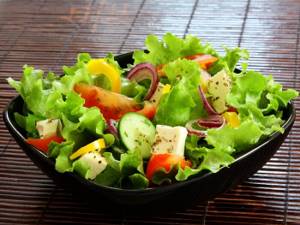
Adyghe cheese is eaten as an independent snack or added to the following dishes:
- vegetable salads;
- rolls;
- pizza, khachapuri;
- soups;
- vareniki;
- cheese masses;
- pies and pies;
- cheese sauces;
- wrapped in puff pastry, lavash.
Fried cheese is especially popular. The structure of the product allows it to be subjected to all types of heat treatment. It can be fried in a regular frying pan or on the grill to give it a specific smoky flavor. Fry the cheese in a drop of vegetable oil for 1 minute on each side until a thick crust forms.
Fresh Adyghe cheese can replace suluguni, mozzarella and other types of soft dairy products [8]. Dried, it is best to grate into pasta, scrambled eggs or salad. You can prepare dried Circassian bars at home: leave the fresh product unpacked in the refrigerator, covering the surface with a linen napkin. In a month, dried Adyghe cheese will be ready.
Features of industrial production
Interesting: cheese became a brand in 1980. It was during this period that its industrial production began. Since then, a cheese festival has been held annually in the city of Maykop (Republic of Adygea). During the holiday, locals organize themed fairs, dress up in ethnic outfits, and prepare many varieties of cheese.
How is the product prepared [9]? The milk mixture is heated to 95°C, after which fermented milk whey is introduced. Once the whey has curdled, the milk curds are collected in willow baskets. These baskets leave a beautiful, recognizable pattern on the sides of the Adyghe cheese. The head is formed in the same basket. This manufacturing method allows you to preserve the nutritional properties of the product and additionally disinfects it. The output is low cheese cylinders. Their weight does not exceed 2 kilograms. Their surface is convex and the edges are rounded. The ideal cylinder is stable and elastic when pressed, and the inside is tender and soft. The aroma of the product is very reminiscent of baked milk with a subtle sour taste.
Important: the price of the finished product may vary depending on the quality of the raw materials and the authority of the manufacturer [10]. The average market value is $6-10/1 kilogram.
Harm and contraindications
Despite its healing properties, Adyghe cheese, like any product, should not be overused. There are some contraindications:
- lactose intolerance;
- Excessive consumption can lead to obesity due to the high amount of saturated fat;
- the amino acid tryptophan contained in cheese, if consumed in excess, can lead to migraines, insomnia and nightmares;
- contraindicated for children under ten months;
- during lactation it can increase the fat content of milk;
- special forms of urolithiasis, excluding calcified foods;
- after the expiration date may cause poisoning.
How to make Adyghe cheese at home
We will need:
- cow's milk - 2 liters;
- fermented milk product to taste (kefir/whey/yogurt) – 3 liters.
Best materials of the month
- Coronaviruses: SARS-CoV-2 (COVID-19)
- Antibiotics for the prevention and treatment of COVID-19: how effective are they?
- The most common "office" diseases
- Does vodka kill coronavirus?
- How to stay alive on our roads?
Preparation
Bring the milk to a boil, pour the fermented milk product into it and mix thoroughly several times. After some time, curd flakes will appear on the surface. As soon as this happens, turn off the heat. After a few minutes, the flakes will disappear and the serum will take on a clear or slightly greenish tint. Pour the finished mixture into a colander/sieve/special mold for making cheese. After 10 minutes, turn the mixture over and leave for 10-12 hours until the whey has completely drained.
The finished cheese can be salted or soaked in a solution of salt and spices, but this is optional. Brine solution recipe: 1 tablespoon whey + 3 tablespoons salt. Soak the cheese for 2-5 days, depending on the desired saltiness of the product. The aged mass must be placed in the refrigerator for 2-3 days, after which the snack is considered ready.
